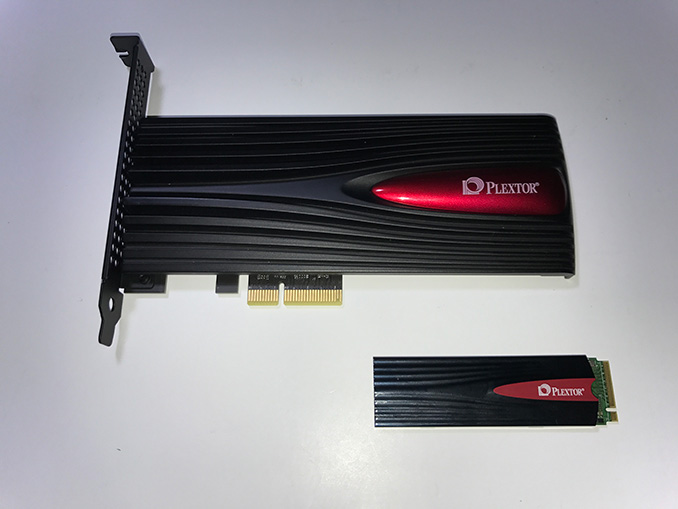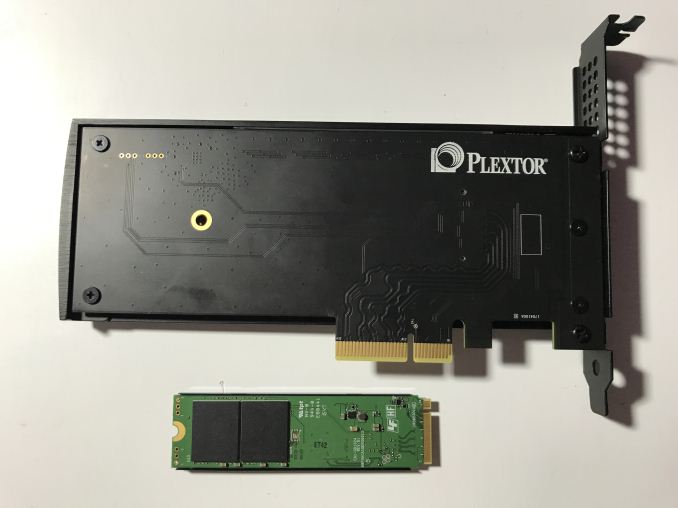Plextor Announces M9Pe SSD: 3.1 GB/s, Marvell Controller, 64-Layer 3D TLC, RGB LEDs
by Anton Shilov on June 2, 2017 10:00 AM EST- Posted in
- SSDs
- Marvell
- Plextor
- 3D NAND
- BiCS
- Computex 2017
- Plextor M9Pe

Plextor has announced its next-generation high-end SSD, the M9Pe. The new drive will use Toshiba’s 64-layer 3D TLC NAND memory and a Marvell controller, and will be available in configurations of up to 1 TB. Plextor says that it is planning to bring the drive to market by the end of this year.
When it comes to high-end SSDs Plextor has returned to its yearly update cycle, and at this Computex the company announced the successor of the M8Pe drive it launched 12 months ago: the M9Pe. Lite-On, the company behind Plextor SSDs, continued to work with Marvell and Toshiba, who supplied controllers and NAND for the previous-generation drives. For Plextor it is logical to keep the old relationship, especially given the shortage of flash memory on the market.
For the Plextor M9Pe, the manufacturer has chosen the Marvell 88SS1093 BTB2 controller as well as Toshiba’s 512 Gb BiCS 3D TLC NAND memory. The 88SS1093 BTB2 controller is equipped with three cores and features 8 NAND channels with 4 CE per channel (32 targets in total). The IC supports a Marvell’s third-generation ECC technology based on the LDPC algorithm and uses PCIe 3.0 x4 interface. Essentially the chip is an updated version of the 88SS1093 with higher frequencies and performance, which makes a lot of sense for higher-end SSDs. It is still an NVMe 1.1 IC, so do not expect any features of the latest NVMe 1.3 spec. Meanwhile, Plextor promises stable performance in sustained use cases, and this is what matters most.
Plextor will offer its M9Pe drives in 256 GB, 512 GB and 1 TB configurations. As for performance, we are looking at up to 3100 MB/s sequential read speed and around 2300 MB/s sequential write speed for the higher-end models, but as the numbers are preliminary; commercial devices might perform differently than the engineering samples the company is testing now. As for form-factors, Plextor plans to offer both an M.2 form-factor card with a radiator, as well as add-in-cards with a larger cooling system featuring RGB LEDs.
Plextor intends to bring its M9Pe drives to market by the end of the year. Pricing is something that is hard to tell today because it will depend on multiple factors, including competitive environment, and of course, where NAND prices are later this year.
Source: Plextor












41 Comments
View All Comments
peevee - Friday, June 2, 2017 - link
The PCIe card is x4, right?DanNeely - Friday, June 2, 2017 - link
Yes. It's x4 physically, and to hit the rated speeds (>2GBps) needs a 3.0 x4 link.XZerg - Friday, June 2, 2017 - link
i do care about performance but really for MOST USE CASES the benefit of going beyond sata SSD just doesn't matter significantly.sadly the price has just not moved down in the past 6 months+ and instead it has gone up since December 2016. Personally I am waiting for 1TB m.2 drive for around $150USD which should have been possible with the number of enhancements - TLC, VNAND, ... yet, it seems there has been no downstream impact. worse yet it seems like the enthusiasm has just died down to even release new products. we are rarely seeing new models getting launched like previous years - dozen every quarter across all producers...
BillyONeal - Friday, June 2, 2017 - link
Neither TLC nor VNAND reduce costs enough to do that, and demand for NAND has gone through the roof. Higher demand == higher prices.ddriver - Friday, June 2, 2017 - link
Actually the NAND scarcity is artificially produced by chip makers so they get better margins. It is not an issue of manufacturing capacity, they are deliberately holding out to maximize profits. And regulators do not mind.edzieba - Friday, June 2, 2017 - link
No, it really is demand growing faster than fabs can be brought online. Fabs are a fixed cost to set up, chip makers gain NOTHING by artificially reducing output. All that accomplishes is reducing sales, which reduces profits.ddriver - Friday, June 2, 2017 - link
Don't be naive. Couple of months back China announced the construction of a NAND mega-fab and all "analysts" were whining how "disruptive" that would be to the flash market.If the shortage is genuine, how is more production disruptive in any way? That would be good news everyone should cheer at.
It is only disruptive if it will end the artificial scarcity and reduce prices.
There is the cost to build a fab. There is the cost to operate a fab. Chip makers are making more money on doing less work. The fab is not going anywhere, it is already built. It doesn't reduce sales, they are not throwing away demand, they just keep supply really tight in order to keep prices inflated. They still sell as much as people are willing to buy, just at considerably higher prices.
It is not unprecedented, misuse of artificial scarcity goes as further back as human history.
melgross - Friday, June 2, 2017 - link
No, it's very high demand. Don't make up conspiracies that don't exist.ddriver - Friday, June 2, 2017 - link
Care to substantiate those claims with facts?Or at the very least provide an adequate explanation why increased NAND supply would be DISRUPTIVE?
Humor me.
ddriver - Friday, June 2, 2017 - link
Or explain how come SSD availability is actually great, if there is indeed nand SHORTAGE then there should also be SSD shortage. Yet there is none, 95% of the ~200 SSD models my local supplier offers are available in stock and in good quantities.